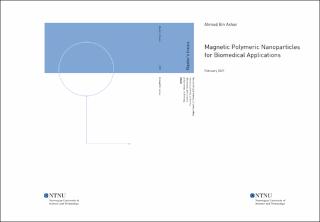| dc.description.abstract | Iron Oxide Nanoparticles (IONPs) have been extensively used in different applications including biomedicine, hydrology, and catalysis. This is because IONPs have excellent physico-chemical properties like superparamagnetism. These IONPs can be encapsulated into various polymers using different techniques like emulsion-diffusion, salting out, and nanoprecipitation whereby increasing their applicability in various fields.
Many researchers have investigated the encapsulation of hydrophobic moieties into polymers by the using the technique of nanoprecipitation but very few research papers have been published where hydrophilic moieties are encapsulated into polymers by the above-mentioned technique. The aim of this project was to encapsulate the hydrophilic moieties i.e., IONPs into different polymers by using nanoprecipitation.
In this master thesis, firstly IONPs and bare polymeric NPs of PLGA were synthesized using the technique of co-precipitation and nanoprecipitation, respectively in section 4.1. Secondly, IONPs were then encapsulated by PLGA NPs using the technique of nanoprecipitation. This encapsulation process was optimized via different methodology which are briefly discussed in section 4.2. Thirdly, the study of different parameters like polymer amount, amount of IONPs, Aqueous/Organic ratio and injection rate that can influence the PLGA encapsulated IONPs size was performed using a statistical software i.e., JMP in section 4.3. Finally, in the last section 4.4, bare PLGA NPs and PLGA encapsulated IONPs were loading with a hydrophobic drug i.e., coumarin. The IONPs were characterized using High Resolution Transmission Electron Microscopy (HRTEM), PLGA encapsulated IONPs were characterized using Dynamic Light Scattering (DLS) and drug loading efficiency was estimated using Ultra Violet Visible Spectroscopy (UV-Vis).
The IONPs synthesized by co-precipitation method had polydisperse population with an average diameter of 15 ± 2 nm. The hydrodynamic size of PLGA NPs before encapsulation with the IONPs was in the range of 80-110 nm. After encapsulation of the IONPs with PLGA NPs, the hydrodynamic size was obtained in the range from 400-800 nm. The process of encapsulation of IONPs with PLGA NPs was successfully optimized using different methodologies. The JMP design for study of different parameters was performed using screening design. In screening design, backward selection of the least significant variable in the data set is done. Because the least significant variable has the maximum effect on the data set. In the first JMP design, Fe/Polymer ratio and molecular weight of polymer were the least significant variables. In the second JMP study, molecular weight, and amount of IONPs were found to be the least significant variables. In the last study, coumarin was loaded in PLGA NPs and PLGA encapsulated IONPs. The drug loading efficiency for bare PLGA NPs was found to be around 92 % and for PLGA encapsulated IONPs it was around 90 % when highest amount of drug was used. Hence, in this project, successful encapsulation of IONPs (hydrophilic moieties) and drug loading of coumarin in PLGA encapsulated IONPs was achieved by the technique of nanoprecipitation which has not been reported in the literature until date. | |
